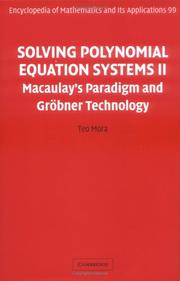| Listing 1 - 3 of 3 |
Sort by
|

ISBN: 9781107340954 9780521811569 1107340950 9781107266902 1107266904 9781299707610 1299707610 9781107269989 1107269989 9780521811545 0521811546 0521811562 9780521811552 0521811554 1139883003 1107266556 110726443X 1107263344 1107267978 9781139015998 Year: 2005 Volume: v. 99 Publisher: Cambridge : Cambridge University Press,
Abstract | Keywords | Export | Availability | Bookmark
 Loading...
Loading...Choose an application
- Reference Manager
- EndNote
- RefWorks (Direct export to RefWorks)
The second volume of this comprehensive treatise focusses on Buchberger theory and its application to the algorithmic view of commutative algebra. In distinction to other works, the presentation here is based on the intrinsic linear algebra structure of Groebner bases, and thus elementary considerations lead easily to the state-of-the-art in issues of implementation. The same language describes the applications of Groebner technology to the central problems of commutative algebra. The book can be also used as a reference on elementary ideal theory and a source for the state-of-the-art in its algorithmization. Aiming to provide a complete survey on Groebner bases and their applications, the author also includes advanced aspects of Buchberger theory, such as the complexity of the algorithm, Galligo's theorem, the optimality of degrevlex, the Gianni-Kalkbrener theorem, the FGLM algorithm, and so on. Thus it will be essential for all workers in commutative algebra, computational algebra and algebraic geometry.
Equations --- Polynomials. --- Iterative methods (Mathematics) --- Iteration (Mathematics) --- Numerical analysis --- Algebra --- Numerical solutions. --- Graphic methods --- Gröbner bases. --- Gröbner basis theory --- Commutative algebra

ISBN: 3540273573 3540243267 3642063616 Year: 2005 Publisher: Berlin, Heidelberg : Springer Berlin Heidelberg : Imprint: Springer,
Abstract | Keywords | Export | Availability | Bookmark
 Loading...
Loading...Choose an application
- Reference Manager
- EndNote
- RefWorks (Direct export to RefWorks)
The subject of this book is the solution of polynomial equations, that is, s- tems of (generally) non-linear algebraic equations. This study is at the heart of several areas of mathematics and its applications. It has provided the - tivation for advances in di?erent branches of mathematics such as algebra, geometry, topology, and numerical analysis. In recent years, an explosive - velopment of algorithms and software has made it possible to solve many problems which had been intractable up to then and greatly expanded the areas of applications to include robotics, machine vision, signal processing, structural molecular biology, computer-aided design and geometric modelling, as well as certain areas of statistics, optimization and game theory, and b- logical networks. At the same time, symbolic computation has proved to be an invaluable tool for experimentation and conjecture in pure mathematics. As a consequence, the interest in e?ective algebraic geometry and computer algebrahasextendedwellbeyonditsoriginalconstituencyofpureandapplied mathematicians and computer scientists, to encompass many other scientists and engineers. While the core of the subject remains algebraic geometry, it also calls upon many other aspects of mathematics and theoretical computer science, ranging from numerical methods, di?erential equations and number theory to discrete geometry, combinatorics and complexity theory. Thegoalofthisbookistoprovideageneralintroduction tomodernma- ematical aspects in computing with multivariate polynomials and in solving algebraic systems.
Equations --- Polynomials. --- Numerical solutions. --- Algebra --- Graphic methods --- Algebra. --- Algorithms. --- Symbolic and Algebraic Manipulation. --- Data processing. --- Algorism --- Arithmetic --- Mathematics --- Mathematical analysis --- Foundations --- Polynomials --- 512.7 --- 512.7 Algebraic geometry. Commutative rings and algebras --- Algebraic geometry. Commutative rings and algebras --- Numerical solutions --- Computer science—Mathematics.
Book
ISBN: 1280460660 9786610460663 0387286950 Year: 2005 Publisher: New York, NY : Springer New York : Imprint: Springer,
Abstract | Keywords | Export | Availability | Bookmark
 Loading...
Loading...Choose an application
- Reference Manager
- EndNote
- RefWorks (Direct export to RefWorks)
This book was written for statisticians, computer scientists, geographers, researchers, and others interested in visualizing data. It presents a unique foundation for producing almost every quantitative graphic found in scientific journals, newspapers, statistical packages, and data visualization systems. While the tangible results of this work have been several visualization software libraries, this book focuses on the deep structures involved in producing quantitative graphics from data. What are the rules that underlie the production of pie charts, bar charts, scatterplots, function plots, maps, mosaics, and radar charts? Those less interested in the theoretical and mathematical foundations can still get a sense of the richness and structure of the system by examining the numerous and often unique color graphics it can produce. The second edition is almost twice the size of the original, with six new chapters and substantial revision. Much of the added material makes this book suitable for survey courses in visualization and statistical graphics. From reviews of the first edition: "Destined to become a landmark in statistical graphics, this book provides a formal description of graphics, particularly static graphics, playing much the same role for graphics as probability theory played for statistics." Journal of the American Statistical Association "Wilkinson’s careful scholarship shows around every corner. This is a tour de force of the highest order." Psychometrika "All geography and map libraries should add this book to their collections; the serious scholar of quantitative data graphics will place this book on the same shelf with those by Edward Tufte, and volumes by Cleveland, Bertin, Monmonier, MacEachren, among others, and continue the unending task of proselytizing for the best in statistical data presentation by example and through scholarship like that of Leland Wilkinson." Cartographic Perspectives "In summary, this is certainly a remarkable book and a new ambitious step for the development and application of statistical graphics." Computational Statistics and Data Analysis About the author: Leland Wilkinson is Senior VP, SPSS Inc. and Adjunct Professor of Statistics at Northwestern University. He is also affiliated with the Computer Science department at The University of Illinois at Chicago. He wrote the SYSTAT statistical package and founded SYSTAT Inc. in 1984. Wilkinson joined SPSS in a 1994 acquisition and now works on research and development of visual analytics and statistics. He is a Fellow of the ASA. In addition to journal articles and the original SYSTAT computer program and manuals, Wilkinson is the author (with Grant Blank and Chris Gruber) of Desktop Data Analysis with SYSTAT. .
Statistics --- Computer graphics. --- Graphic methods --- Data processing. --- Automatic drafting --- Graphic data processing --- Graphics, Computer --- Computer art --- Graphic arts --- Electronic data processing --- Engineering graphics --- Image processing --- Digital techniques --- Statistical analysis --- Statistical data --- Statistical methods --- Statistical science --- Mathematics --- Econometrics --- Mathematical statistics. --- Visualization. --- Computer vision. --- Statistics and Computing/Statistics Programs. --- Computer Imaging, Vision, Pattern Recognition and Graphics. --- Machine vision --- Vision, Computer --- Artificial intelligence --- Pattern recognition systems --- Statistical inference --- Statistics, Mathematical --- Probabilities --- Sampling (Statistics) --- Visualisation --- Imagination --- Visual perception --- Imagery (Psychology) --- Statistics . --- Mathematics. --- Optical data processing. --- Optical computing --- Visual data processing --- Bionics --- Integrated optics --- Photonics --- Computers --- Math --- Science --- Optical equipment --- Mathematical statistics—Data processing. --- Information visualization. --- Image processing—Digital techniques. --- Statistics and Computing. --- Data and Information Visualization. --- Data visualization --- Visualization of information --- Information science --- Visual analytics
| Listing 1 - 3 of 3 |
Sort by
|

 Search
Search Feedback
Feedback About
About Help
Help News
News